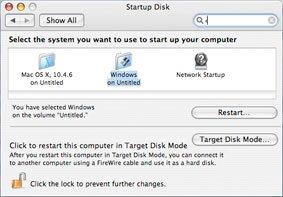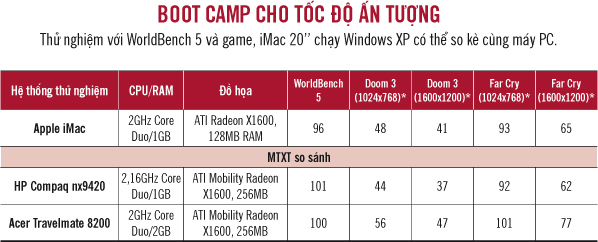Boot Camp brings XP to a Mac
Apple's testing software creates a two-system boot system quickly and easily.
Windows XP is available on Intel-based Macs, thanks to two new software: Apple's Boot Camp and Parallels Workstation 2.1 from Parallels. Test shows that Boot Camp is suitable for those who like to use OS X but still need to go to Windows to work or play games.
Boot Camp and Parallels Workstation offer 2 different ways to bring Windows to Mac. Apple's utility helps automate the process of creating a dual-boot machine with Windows working in real mode. This function will be integrated in the next version of Mac OS X operating system, Leopard. In contrast, Parallels, a $ 40 download, uses Intel's virtualization technology to run Windows and other operating systems inside OS X.
Try installing Boot Camp on the iMac to show that the process is very smooth. The graphics drivers have no problems and the iMac 20 screen responds to the application and game quite well. In a virtual operating system environment, Parallels can't run PC WorldBench 5 or game tests, but it works fine.
Works with Boot Camp

The Startup Disk settings page of Boot Camp is where you choose which operating system will start by default.
Boot Camp only works with Intel-based Mac systems, requires the latest Mac OS X OS (10.4.6) and must update the firmware. After the computer has been updated, you can download, install and run Boot Camp Assistant, the program will burn a driver CD for Windows, help you to reinstall the hard drive partition and install Windows XP.
On iMac tested machines, Boot Camp cleverly handles a variety of restart tasks that require Windows XP installation. Once the system is fully configured, you can press and hold the key while booting to select the OS you want to run. Boot Camp also installs a reference page of OS X and an XP Control Panel applet for you to select the default OS. In general, with Boot Camp, the system works like a real Windows PC in testing basic applications, exactly as you'd expect from a dual-boot machine. The download and installation of Firefox does not occur and iTunes downloads music easily from other computers on the network. Both wired and wireless networks work well. What about the speed of Boot Camp? Very impressive. The hardware of the iMac 20 tested similar to a high-end laptop, the app and game test results were as expected (see table).

In contrast, Parallels is still the same as a virtual operating system. The speed is slower although the environment is almost stable and can run applications that do not require heavy processing capability. This is not a solution for gamers, but for anyone who likes to experience new feelings with OS X, Parallels may be a good choice.
You should read it
- OS X upgrade version 10.8.3 supports Windows 8 installation
- Instructions for installing Windows on a Mac with Boot Camp
- How to Use Boot Camp
- 5 steps to install Windows 10 on a Mac
- How to run Windows programs on Mac
- Parallels Desktop 18 is out and ready for macOS Ventura
- Apple updates Boot Camp and firmware for MacBook
- Instructions for running Windows 11 on a Mac with Parallels 17
May be interested
- Instructions on how to create a Windows 10 USB install on macOS
 detailed instructions on how to create a windows 10 installer on macos is extremely simple. tips to create a set of win 10 on macbook using boot camp assistant
detailed instructions on how to create a windows 10 installer on macos is extremely simple. tips to create a set of win 10 on macbook using boot camp assistant - DLC Boot - Download DLC Boot here
 dlc boot is a troubleshooting utility that allows users to find and fix problems present in the pc. the application includes various tools that help determine the status of software and hardware installed on a desktop or laptop computer.
dlc boot is a troubleshooting utility that allows users to find and fix problems present in the pc. the application includes various tools that help determine the status of software and hardware installed on a desktop or laptop computer. - Some Macs cannot install the Windows 10 update May 2019 Update
 macs that are using boot camp to run windows 10 may have trouble updating to windows 10 version may 2019 update.
macs that are using boot camp to run windows 10 may have trouble updating to windows 10 version may 2019 update. - What is Boot Sector?
 boot sector is a physical area, or part of a hard drive, that includes information on how to start the boot process to load an operating system.
boot sector is a physical area, or part of a hard drive, that includes information on how to start the boot process to load an operating system. - How to create USB Boot, USB install Windows by Rufus
 how to create usb boot installed win is pretty much, you can create usb boot with hiren's boot cd, universal usb installer, ... but the quick, easiest way is to create a boot usb with rufus. the following is a guide to creating a usb boot using rufus for your reference.
how to create usb boot installed win is pretty much, you can create usb boot with hiren's boot cd, universal usb installer, ... but the quick, easiest way is to create a boot usb with rufus. the following is a guide to creating a usb boot using rufus for your reference. - 20 best USB boot software
 20 this usb boot software will help you create usb boot, usb install win quickly, easily, even can create usb boot containing many operating systems.
20 this usb boot software will help you create usb boot, usb install win quickly, easily, even can create usb boot containing many operating systems. - How to implement Clean Boot on Windows 10/8/7
 clean boot state is used to diagnose and fix problems on windows. if your computer cannot start normally or if during the boot process you receive an error message, then you might consider performing a clean boot.
clean boot state is used to diagnose and fix problems on windows. if your computer cannot start normally or if during the boot process you receive an error message, then you might consider performing a clean boot. - Can USB Boot save data?
 what is usb boot? can usb boot save data? refer to usb boot features and instructions on how to create usb boot quickly and conveniently.
what is usb boot? can usb boot save data? refer to usb boot features and instructions on how to create usb boot quickly and conveniently. - Instructions for creating a USB Boot to rescue your computer using Hiren's Boot
 usb boot is an integrated toolkit that helps you fix many computer software errors. in this article, hanoicomputer will guide you how to create a usb boot with hiren's boot through the latest dlc boot 2020 installation package.
usb boot is an integrated toolkit that helps you fix many computer software errors. in this article, hanoicomputer will guide you how to create a usb boot with hiren's boot through the latest dlc boot 2020 installation package. - What is a Volume Boot Code?
 the volume boot code is required by the master boot code and is used to boot the boot manager, which begins the actual loading process of the operating system.
the volume boot code is required by the master boot code and is used to boot the boot manager, which begins the actual loading process of the operating system.










 Use Vista operating system on MacBook Pro
Use Vista operating system on MacBook Pro 15 things should not be in Mac OS X
15 things should not be in Mac OS X The Mac software hunt
The Mac software hunt Install Windows Vista on Mac using Boot Camp
Install Windows Vista on Mac using Boot Camp Refresh the Mac
Refresh the Mac 'Turn' your Mac into a Wi-Fi Access Point
'Turn' your Mac into a Wi-Fi Access Point